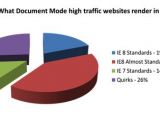As Microsoft is laboring to produce Internet Explorer 9, the company has revealed that, a year after launch, IE8 uses compatibility view for over 2,000 high-traffic websites, or the other way around, although more and more web developers are falling in line. In order to prevent IE8 from breaking the web, Microsoft has built no less than three rendering modes into the browser: Quirks mode, IE7 Standards Mode and IE8 Standards Mode, only the latter of which is illustrative of the browser’s support for modern web standards.
IE8 continues to check websites for the right Document Mode, which needs to be used in order to render the content so that end users will enjoy the best browsing experience possible. Choosing between Quirks or Standards Modes could be the difference between a page displayed normally, and an unintelligible website.
Of course, ultimately, developers have to put in the work and make sure that their content is compatible with Internet Explorer 8. While some web devs have indeed embraced IE8, others are still relying on the browser’s different modes to display their websites properly. Microsoft is constantly updating the Windows Internet Explorer 8 Compatibility View List, and notes that, in the past year, over 1,000 websites have become IE8 friendly.
“This list is down by over 1000 websites, from over 3100 to just over 2000, since IE8 released last March. As we work with site developers and standards bodies, we’re excited to see the sites that need to be on the Compatibility View (CV) List continue to go down,” Marc Silbey, IE program manager, stated.
“When looking at the doctype and X-UA-Compatible meta tag and header on thousands of high traffic websites worldwide such as qq.com, netlog.com and those on the initial CV List, 26% specify Quirks such as amazon.com, tworld.co.kr, and unibanco.com.br. 41% specify a Transitional doctype that puts them in Almost Standards Mode. 14% have already added an X-UA-Compatible meta tag or HTTP response header to render in IE7 Standards Mode,” Silbey added.
According to Microsoft, 19% of websites render in IE8 Standards, with the vast majority, 41%, rendering in IE8 Almost Standards. This goes to show that devs have indeed worked to adapt content for the latest version of Internet Explorer. Only 14% of websites specify the IE7 Standards and 26% the Quirks Mode for IE6.
“Here’s why this makes sense; many high traffic websites want to render in as many browsers as possible, which is why they write for Quirks. Many websites have pages written specifically for IE7 and many web authoring tools such as Aptana Studio and Expression Web specify the Transitional doctype by default,” Silbey stated. “Thinking in terms of web-scale, there are billions of pages written specifically for either Quirks, IE7, Almost Standards, or the latest Standards. IE needs to support all of these web platform variations to ensure that our broad, world-wide, user-base has the best experience.”
UPDATE (March 5): Modified title and the first paragraph to better reflect IE8's relation with 2,000 high traffic sites.
Internet Explorer 8 (IE8) RTW is available for download here (for 32-bit and 64-bit flavors of Windows XP, Windows Vista, Windows Server 2003 and Windows Server 2008).

 14 DAY TRIAL //
14 DAY TRIAL // 
